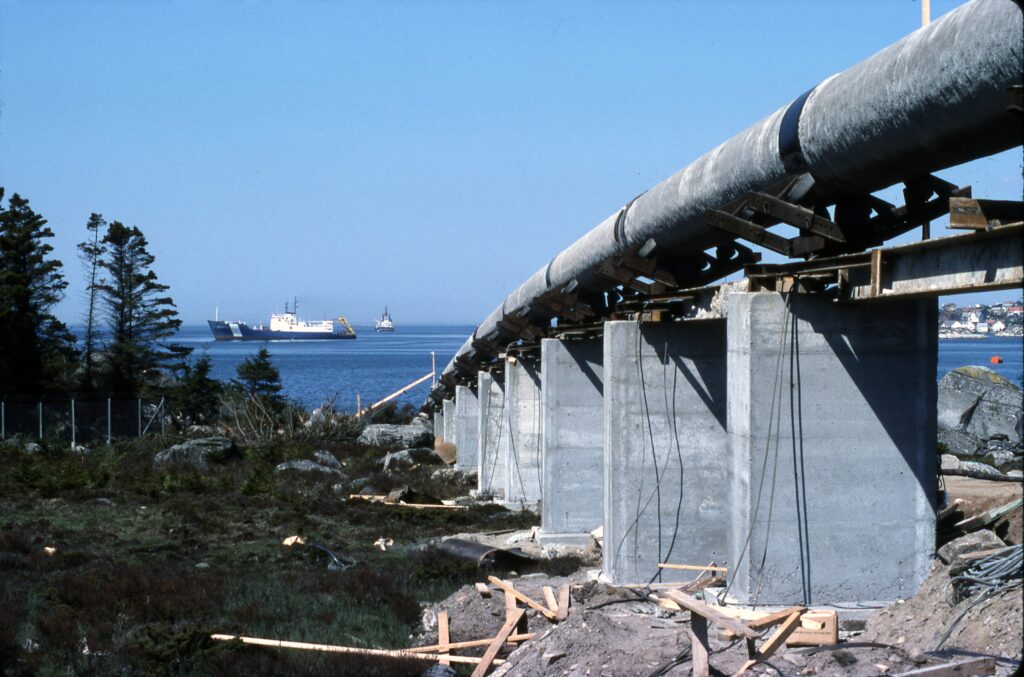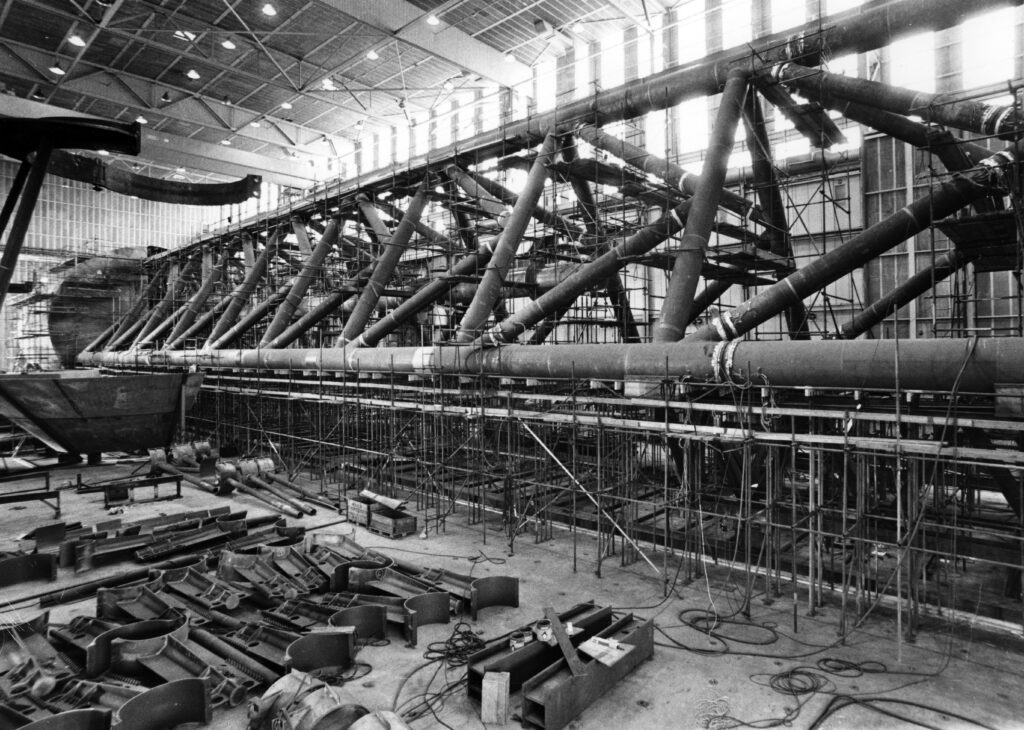Offshore loading on Statfjord

Arve Johnsen and E J Medley, CEOs of Statoil and Statfjord operator Mobil Norge respectively, had overall responsibility for finding solutions for the resources in this giant field.[REMOVE]Fotnote: Estimates indicated that the field would ultimately yield four billion barrels of oil and 150 billion cubic metres of gas – or about 700 million tonnes of oil equivalent.
Medley’s solution was to do what the US oil major usually did where transporting oil was concerned: “Mobil Shipping in New York and Mobil Marine in London can do the job”. He proposed that the Statfjord group should establish a shipping company in Bermuda to buy tanker tonnage from Mobil for chartering to these American and British companies.
But Johnsen had little enthusiasm for that idea, which would primarily benefit Mobil and do little for Statoil. The latter, after all, had a 50 per cent interest in the Norwegian share of the field and in transport from it. From his first day at Statoil, Johnsen’s clear aim was to make it a fully integrated oil company covering every stage from exploration to production, landing, processing and distribution. That Mobil, with a 15 per cent holding in Norway’s part of the field, should have control of the transport stage was therefore out of the question. Johnsen believed Statoil should be operator for this activity.
The company’s long-term aim was take over the Statfjord operatorship after 10 years, when its “apprenticeship” had been completed. Securing control of landing oil and gas from the field was a step towards this primary goal. Disputes over the transport operatorship lasted until 1978-79 for oil and to 1981 for gas.
Fighting for control
Statoil already had experience of gaining control over the transport phase after its fight with Phillips Petroleum in 1973. The latter was compelled – almost in shock – to allow the company to take over the Norpipe pipeline system from Ekofisk. On Frigg, where it had a small interest through the Petronord group, Statoil pressed for the gas to be piped to Karmøy island north of Stavanger. In this case, however, the company had to yield and agree with Norway’s Norsk Hydro group that a Norwegian landfall would be too expensive and threaten the whole development.[REMOVE]Fotnote: Board minutes, Statoil, item 14/75-2.
The battle over piping oil from Statfjord to mainland Norway had just got going at the time. Johnsen secured board backing for the argument that Statoil, as the largest licensee, was the natural candidate to take lead responsibility for a feasibility study on a landfall.[REMOVE]Fotnote: Board minutes, Statoil, item 9/75-12. That won support in the Statoil/Mobil licensee group.
Oil transport study
Work on the transport study began in the autumn of 1974.[REMOVE]Fotnote: Board minutes, Statoil, item 15/75-3. Although Statoil’s primary goal was an oil pipeline to land, offshore loading into tankers had to be considered in the same detail. The conclusions in its preliminary report were the opposite of the company’s own wishes. If Statfjord was to become operational quickly, oil output in the first phase would have to be loaded via buoys into shuttle tankers for shipment to a receiving terminal. In this context, “first phase” was the key for Statoil. The report recommended converting to pipeline transport in the next stage rather that sticking to offshore loading. That would provide better operational regularity since it was not weather dependent. Other advantages included transporting large amounts of natural gas liquids with the oil for use as petrochemical feedstock, and more protection against pollution.[REMOVE]Fotnote: Board minutes, Statoil, item 14/75-4.

A pipeline could be brought ashore in either Norway or the UK. Eight Norwegian landfall locations were subject to a preliminary assessment. Mongstad north of Bergen, where Rafinor already had a small refinery, was the first choice – but a pipeline would then have to cross the Norwegian Trench at a depth of 500 metres. Soundings showed that nearby Sotra, for example, was less difficult.
Sites assessed outside Norway included Shetland, Orkney or offshore loading and a tie-in to the Ninian pipeline to the UK. Shetland had the most favourable bottom conditions for an oil pipeline, and was assessed as equal to Norway in cost terms.
The Norwegian options called for more research and technical tests before reaching a final conclusion. New equipment and procedures would need to be developed.[REMOVE]Fotnote: Board minutes, Statoil, item 1/75-2. Issues such as mooring in the Trench, repair techniques during laying and operation, trenching oil pipelines and the arrival in the shore zone needed closer investigation.[REMOVE]Fotnote: Board minutes, Statoil, item 14/75-4.
The earliest possible laying season was the summer of 1979. Statoil also maintained that it would be important to establish a gas pipeline from Statfjord as soon as possible.

When the preliminary report was discussed by the Statoil/Mobil group, Mobil and others sharply criticised the high cost of pipeline development programmes. The partners would only yield to a direct command from the Storting (parliament).
Mobil believed financial considerations meant offshore loading was the best solution. This would also make it possible to land the oil in Norway and thereby satisfy government requirements. However, Statoil did not want to give up, and investigated the chances of securing political support for further studies with the pipeline option. Meetings were held with Bjartmar Gjerde, the Labour government’s industry minister, and the Storting’s standing committee on industry. These showed some understanding of the need for more research on opportunities to lay a pipeline to Norway.[REMOVE]Fotnote: Board minutes, Statoil, item 15/75-3, “Statfjord. Utbyggingsplan fase 2”.
When the issue of Statfjord’s development and landing options was debated in the Storting on 16 June 1979, two loading buoys for the field were approved for the time being. At the same time, the politicians decided that the Statoil/Mobil group would conduct further studies of a possible oil pipeline to Sotra. Statoil had won a small victory over Mobil.
Temporary agreement
The Storting decision was followed by difficult negotiations among the licensees over who was to be in charge of offshore loading and oil transport. Statoil had limited experience and had only participated in the use of shuttle tankers on Ekofisk, while Mobil was accustomed to organising oil shipments. The Norwegian company nevertheless succeeded in securing control because it was the biggest licensee on Norway’s side of the field.
Mobil agreed that the transport system should be organised and led from Stavanger, with Statoil as operator. But the latter was to collaborate with the US company on identifying suitable vessel types and loading systems.[REMOVE]Fotnote: Board minutes, Statoil, item 3/76-9, “Sjøtransport Statfjordprosjektet” (doc 23/76).
Johnsen took personal control over how this was to be implemented. He was mandated by the board to charter a sufficient number of vessels for landing the oil in phase one. After an urgent meeting with chair Finn Lied and the deputy chair in June 1976, Johnsen personally negotiated a five-year charter for two new tankers with the Einar Rasmussens Rederi shipping company in Kristiansand.[REMOVE]Fotnote: Board minutes, Statoil, item 7/76-7, “Transportløsning for Statfjord fase I” (doc 58/76). Such an agreement was in line with Johnsen’s vision that Statoil would provide work for Norwegian businesses. That was not least important during the shipping crisis in the second half of the 1970s.
Later the same year, the Statoil board approved spending almost NOK 500 000 on three research projects – hoses for loading buoys, dynamic positioning of tankers and model trials with oil booms. [REMOVE]Fotnote: Board minutes, Statoil, item 10/76-10, “Tilleggsbevilgninger”; The loading buoys on Statfjord – Statfjord (industriminne.no). Polytraveller, the first of the two tankers, was ready in August 1978. The licensees then entered into a temporary transport agreement based on their share of interests in Statfjord. This limited partnership was named K/S Statfjord Transport a.s. & Co.[REMOVE]Fotnote: https://www.nb.no/items/8c02fbb481bdd7276bfe4cb60b4eb2ae?page=75&searchText=arve%20johnsen. Statoil was operator with a 50 per cent share and staffer Erik Schanche as chair.[REMOVE]Fotnote: K/S Statfjord Transport a.s & Co had the same partner composition as the field, with no less than 12 participants. Lindøe, John Ove, 2009, From sea to shore, Stavanger: 20. The specially equipped tankers from Rasmussen would ship the oil to refineries and terminals throughout northern Europe.
A dedicated loading technique was eventually developed for Statfjord in collaboration with Norwegian shipping companies and equipment suppliers. Polytraveller lifted the first cargo from Statfjord on 9 December 1979. Sister ships Polytrader and Polyviking were also allocated to transporting oil from the field.[REMOVE]Fotnote: Ibid: 29-35.
Offshore loading agreement
In the 1970s, Statoil regarded ship transport as a first phase, an intermediate solution until the oil pipeline was in place. But further studies led ultimately to a different conclusion.
A Statfjord unit transport evaluation report, based on further studies of the pipeline and offshore-loading options by Statoil and Mobil respectively, was completed in March 1979. The Statoil section concluded that it might be technically feasible to lay and operate a 207-kilometre oil pipeline across the Trench, via Hjartøy in Øygarden local authority, to Vindenes in northern Sotra. Twenty-four kilometres would run over land.[REMOVE]Fotnote: Its full name was the Statfjord transportation system project.
Before a final decision could be taken, however, further technical development and testing work on laying and operating pipelines in 300-350 metres of water was required. Mobil’s offshore loading study found that this offered the lowest investment and operating costs, reducing the required outlay by NOK 6 billion. It was the cheapest option both immediately and in the long term.
Statoil therefore agreed with the rest of the licensees to apply to the Ministry of Petroleum and Energy for an exemption from the main rule of landing oil in Norway. On the basis of profitability calculations, the group recommended offshore loading as the oil transport system for the field’s whole producing life. That proposal was accepted by the Storting on 23 May 1980.
This “defeat” was taken with composure by Statoil. On the basis of the Statfjord and later Gullfaks fields, it has since built up a fleet of shuttle tankers in collaboration with Norwegian shipping companies. In addition to Rasmussen, Uglands Rederi in Grimstad came to play a key role in this specialist tanker traffic and the development of offshore loading systems. That provided both Statoil and the Norwegian maritime industry with valuable experience. Ugland became for a time the largest company in the world in this niche business.[REMOVE]Fotnote: Johnsen, Arve, 1988, Gjennombrudd og vekst. Statoil-år 1978-87: 69–71; Fire on Polytraveller – Statfjord (industriminne.no)
Navion 1997-2002
From the mid-1990s, Statoil wanted to concentrate more strongly on its core business. The shipping and maritime technology business was therefore split off into a separate company. The latter embraced storage and production ships, shuttle tankers, conventional crude oil and product carriers, gas carriers and maritime technology in general. This enterprise was established on 1 October 1997 under the name Navion AS, and received all Statoil’s assets and rights in the area. The company was initially owned 80 per cent by Statoil and 20 per cent by the Rasmussen group, but creating an independent entity meant that additional shareholders could be brought in.
Navion’s core business was offshore loading of oil with specially equipped tankers, but its scope also included a broad range of services in the maritime offshore sector and oil/gas transport.[REMOVE]Fotnote: Navion established – Statfjord (industriminne.no) Statoil sold out of the company in 2002 since it wanted to concentrate even more clearly on its core activities.
arrow_backKeeping parliament informedStatoil’s first discovery – Tommeliten Alpha 1/9-1arrow_forward